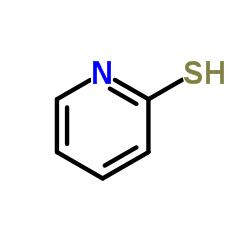2-Pyridinethiol

2-Pyridinethiol structure
|
Common Name | 2-Pyridinethiol | ||
|---|---|---|---|---|
| CAS Number | 2637-34-5 | Molecular Weight | 111.165 | |
| Density | 1.2±0.1 g/cm3 | Boiling Point | 194.0±13.0 °C at 760 mmHg | |
| Molecular Formula | C5H5NS | Melting Point | 127-130 °C(lit.) | |
| MSDS | Chinese USA | Flash Point | 71.1±19.8 °C | |
|
Endothelial cell-targeted pVEGF165 polyplex plays a pivotal role in inhibiting intimal thickening after vascular injury.
Int. J. Nanomedicine 10 , 5751-68, (2015) Upregulation of vascular endothelial growth factor (VEGF) expression can inhibit intimal thickening after vascular injury. However, the lack of efficient gene delivery systems leads to insufficient VEGF expression, which prevents its application in gene thera... |
|
|
Live-cell imaging of biothiols via thiol/disulfide exchange to trigger the photoinduced electron transfer of gold-nanodot sensor
Anal. Chim. Acta 849 , 57-63, (2014) [Display omitted] |
|
|
A Systematic Comparative Study of Hydrogen-Evolving Molecular Catalysts in Aqueous Solutions.
ChemSusChem 8 , 3632-8, (2015) We describe here a systematic, reliable, and fast screening method that allows the comparison of H2-forming catalysts that work under aqueous conditions with two readily prepared chemical reductants and two commonly used photosensitizers. This method uses a C... |
|
|
Testing nucleoside analogues as inhibitors of Bacillus anthracis spore germination in vitro and in macrophage cell culture.
Antimicrob. Agents Chemother. 54 , 5329-36, (2010) Bacillus anthracis, the etiological agent of anthrax, has a dormant stage in its life cycle known as the endospore. When conditions become favorable, spores germinate and transform into vegetative bacteria. In inhalational anthrax, the most fatal manifestatio... |
|
|
Ag-modified Au nanocavity SERS substrates.
Phys. Chem. Chem. Phys. 11(34) , 7469-75, (2009) The engineering of cavity void metallic arrays allows to vary the plasmon-polariton mode energies from the near infrared to the ultraviolet through the tuning of the void height and diameter, and the selection of the appropriate material. Typically Au nanocav... |
|
|
Dioxygen reactivity of biomimetic iron-catecholate and iron-o-aminophenolate complexes of a tris(2-pyridylthio)methanido ligand: aromatic C-C bond cleavage of catecholate versus o-iminobenzosemiquinonate radical formation.
Chemistry 18(37) , 11778-87, (2012) An iron(III)-catecholate complex [L(1)Fe(III)(DBC)] (2) and an iron(II)-o-aminophenolate complex [L(1)Fe(II)(HAP)] (3; where L(1) = tris(2-pyridylthio)methanido anion, DBC = dianionic 3,5-di-tert-butylcatecholate, and HAP = monoanionic 4,6-di-tert-butyl-2-ami... |
|
|
Rearrangement of the tris(2-pyridylthio)methanido ligand in an iron(II) complex containing an Fe-C bond.
Inorg. Chem. 50(3) , 708-10, (2011) Iron(II) tris(2-pyridylthio)methanido (1) containing an Fe-C bond, obtained from the reaction of tris(2-pyridylthio)methane (HL(1)) and iron(II) triflate, reacts with protic acid to generate iron(II) bis(2-pyridylthio)carbene (1a). The carbene complex is conv... |
|
|
Ionization characteristics of the Cys-25/His-159 interactive system and of the modulatory group of papain: resolution of ambiguity by electronic perturbation of the quasi-2-mercaptopyridine leaving group in a new pyrimidyl disulphide reactivity probe.
Biochem. J. 290 ( Pt 1) , 289-96, (1993) 1. A new thiol-specific reactivity probe 4,4'-dipyrimidyl disulphide [compound (VII), m.p. 110 degrees C, pKa of its monohydronated form 0.91] was synthesized and used to resolve the ambiguity of interpretation of the behaviour of papain (EC 3.4.22.2) in alka... |
|
|
Catalytic mechanism of Sulfiredoxin from Saccharomyces cerevisiae passes through an oxidized disulfide sulfiredoxin intermediate that is reduced by thioredoxin.
J. Biol. Chem. 284(48) , 33048-55, (2009) Sulfiredoxin catalyzes the ATP-dependent reduction of overoxidized eukaryotic 2-Cys peroxiredoxin PrxSO(2) into sulfenic PrxSOH. Recent mechanistic studies on sulfiredoxins have validated a catalytic mechanism that includes formation of a phosphoryl intermedi... |
|
|
Synthesis of 1-(beta-D-glycopyranosyl)-3-deazapyrimidines from 2-hydroxy and 2-mercaptopyridines.
Nucleosides Nucleotides 17(8) , 1355-63, (1998) The synthesis of new 4- and 5-substituted-3-cyanopyridine nucleosides has been performed by reacting the silylated pyridines and penta-omicron-acetyl-alpha -D-glycopyranose in dichloroethane in the presence of SnCl4. The free nucleosides were tested for their... |